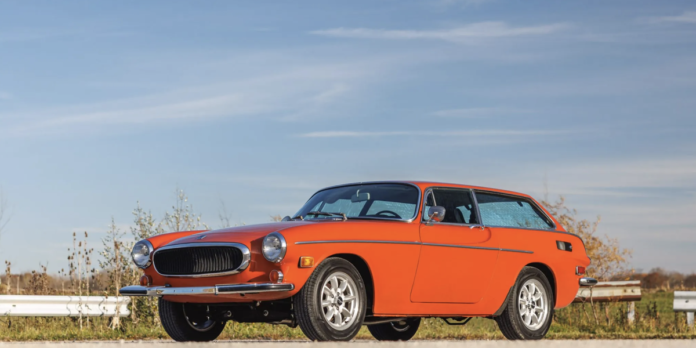- Nicknamed “Snow White’s Coffin,” or Schneewitchensarg, in reference to its large rectangular glass area, the Volvo 1800ES is a shooting brake adaptation of the long-running P1800 coupe.
- Bilstein dampers, IDP front and rear antiroll bars, and 15-inch Panasport wheels with 205/60 Hankook Kinergy ST tires lend a hint of contemporary performance without diluting the car’s true spirit.
- With a recent multi-year restoration under its belt, including fresh paint in the factory orange, and just 85,000 miles on the clock, this is likely one of the cleanest daily-driveable examples currently available.
The Volvo 240 wagon may be the most universally recognized of all Volvo family transports, but it’s far from the most interesting. That title belongs to the Volvo 1800ES, a short-lived shooting brake/wagon/GT/estate amalgam featuring a signature frameless glass rear hatch design that Volvo would revisit in the future. Produced for only two years, this delightfully orange 1973 example is up for bids on Bring a Trailer, which, like Car and Driver, is part of Hearst Autos.
Volvo has a long history of developing wagons or estates, but the 1800ES was a departure, a stylistic statement from a typically staid company. Crafted from the P1800 coupe that debuted as a 1961 model, the P1800ES, typically referred to as the 1800ES, was designed in Göteborg by longtime Volvo design chief Jan Wilsgaard, only after prototypes from Italian designers Sergio Coggiola and Pietro Frua were deemed too radical and futuristic. (Both prototypes are currently on display at the Volvo Museum in Sweden.) Wilsgaard initially designed two proposals, the Jaktvagnen, or hunting car, and the “Beach Car,” which ultimately won out. Wilsgaard, it should be noted, had a hand in numerous groundbreaking designs at Volvo, including the Amazon (P1200), the 144 sedan and 145 wagon, the vaunted 240 and the 740, among others.
Essentially a long-roof extension of the 1800 coupe, the 1800ES deftly blends the enlarged rear quarters into the slightly unbalanced rear design while retaining a hint of the vestigial rear fins. Fans argue that the design streamlines the rear flanks and almost—almost—appears to be the better of the two designs, but the camps are resolutely split. The rectangular glass area, accented by the large glass rear hatch, was so expansive for the time that the 1800ES earned the nickname “Snow White’s Coffin” or Schneewitchensarg, in Germany. (Apparently, the same nickname was also applied to a now iconic transparent-topped record player styled by German designer Dieter Ramsa for Braun Consumer Products a few years earlier.) Some Swedes simply called it the “fish car.”
Production of the 1800ES commenced alongside the 1800 coupe for the 1972 model year. The editors of Car and Driver said at the time that “people have tried to make sports cars out of station wagons, but it took Volvo to successfully reverse the concept.”
Volvo president Stig Jansson was quoted in press materials stating the car would, “appeal to sportsmen and long-distance tourers who are looking for a sports car with ample luggage space. The new model combines the styling of a sports car with the practicality of a station wagon to satisfy the motoring needs of a number of consumers.”
Sadly, that number proved to be smaller than hoped. After just two years of sales, the 1800ES and its 1800 coupe sibling ceased production, with Volvo citing the expense of meeting the changing U.S. bumper regulations as the primary reason. Though some at Volvo thought it might be possible to fit ungainly plastic or rubber bumpers, the consensus was there was no way to do it inexpensively without destroying the car’s looks. Given its relatively slow sales and the coupe’s advanced age, both variants were discontinued at the end of 1973. Most sources agree that only 8078 examples of the 1800ES were produced during its two-year run.
With a claimed 85,000 miles, this example retains its original 2.0-liter 121-horsepower B20 four-cylinder engine with a rebuilt cylinder head with hardened valve seats necessary for unleaded fuel. Modifications include the replacement of the original three-speed automatic transmission with a desirable four-speed with an electric overdrive unit, a four-into-one exhaust header, IPD front and rear antiroll bars, and Bilstein dampers. The interior has been refitted with fresh leather upholstery on the seats. The headliner, interior panels, and dash upholstery were also replaced at that time. With decent finishing and tasteful mechanical modifications, this Volvo 1800ES is clean enough to show but far from a museum piece, so regular exercise shouldn’t cause the owner any bouts of nervous regret.
This auction ends on December 6.

Contributing Editor
Andrew Wendler brings decades of wrenching, writing, and editorial experience with numerous outlets to Car and Driver. A rust-belt native and tireless promoter of the region, he once won a $5 bet by walking the entire length of the elevated People Mover track that encircles downtown Detroit.




